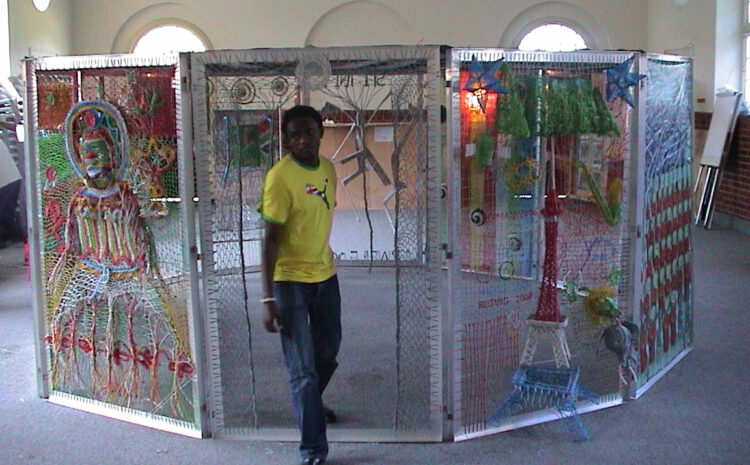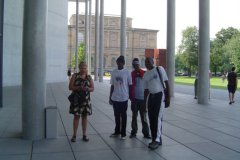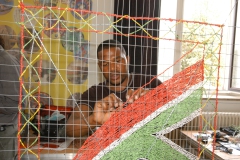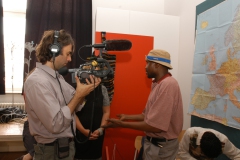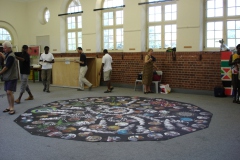Short biographies of the artists
Enoch Ngwenya, Mpulanga Province
was born in 1966. In 1989 he graduated from Khumbula High SchoolMpulanga, where he studied geography, mathematics, biology and languages (Siswati, English and Afrikaans). He makes wirework of various kinds – vases, lamps, tables, flowers, cars and sculptures – and has participated in exhibitions throughout Africa with them, including Burkina Faso in 2000, the Grahamstown National Arts Festival in 2003 and the Johannesburg Rand Show in 2004.
“I made the lines of communication from the ground to the top to show that the communication must start from the ground up to the high level of communicating. I put my silver wire to make my frame strong in the inside and then started to put on the telephone wire. I appreciate the support which is given to our art, here, and I’m curious about how the Europeans like it.”
Alfred Fana Radebe, Gauteng
was born in 1976. He first trained as a security guard with Bakgatlamedi Security before turning to art. From 2001 to 2003 he studied painting, sculpture and art history at the Spies Venter Art Centre in Three Rivers, Vereeniging. In 2002 he showed his works in Gallery 88 in Sasolburg and got his own exhibition in the Vaal Technorama Museum.
“The interpretation of the figures in my frame is to bring all the women in the world together through communication as they were during 1956 marching at Union buildings in Pretoria.
In my decoration I used the chicken wire technique which looks like a fence around the women. One being an African lady communicating to her German friend. “
Zola Hector Sentini, Western Province
was born in 1965 and began making his first wire works at the age of ten. In 1995 he made wire art his profession. Arts and crafts markets and private customers became his main customers. Since 2002, he has collaborated with Wola Nani and Ithemba Africa Project Capetown, where he creates lamps and more. In 2004, he won third prize in a competition for the tenth anniversary celebrations of South African democracy.
“I really appreciate that I have the freedom to create whatever I like. In South Africa, I have to do small art work, but I love producing big things, and that is what I do here. I mix nature (animals) and meaningful men made things (like a television tower).”
Mandla Sibiloane, KwaZulu Natal
was born in 1980. He attended Rathanda High School until 1997. Since 1998 he has been creating various works for the KwaZulu Natal Craft Initiative Durban. He works for the African Arts Centre Durban on a commission basis. In 2002, he was featured in exhibitions at the Drakensburg Festival.
“Not only the contact with the Europeans but also with the African artists is very enriching. I like to see the way the other artists work. The telephone wire is a good material for that purpose, because it is easy to use. When I was a young boy was making wire cars like the people from Zimbabwe. Working in a museum made me very much happy.”
Ceiphas Niyko Maswanganyi, Nothern Province
was born in 1981. In 1999 he created his first wire art under the guidance of his friend, the artist Rhulani. In 1997 he went to Mozambique, where he exhibited his works. After studying at a technical college for three years, he worked as an engine mechanic for three months in 2001. He has received various regional and national awards for his work.
“I enjoyed seeing the work of the other artists and exchanging ideas and techniques. I enjoyed visiting the “Pinakothek der Moderne” where I got to know the work of contemporary Western artists. I was inspired by what I saw there. I would have liked to see the factories where the famous Western cars are designed, because this is my special interest.”
Riaan Booysen, Dos Kaap
was born in 1977. From 1997 to 2000, he trained as an electrician at St. Antons Technical School Port Elisabeth. Inspired by his brother, he began making wire art at the age of eight. He has been selling them ever since, not only on the street but also at festivals, such as the Gramestown Festival and the Summerset Fiest.
“I’m happy to be here. It’s a wonderful project.
Op denstag het ek an dream gehad date k die groates ombenke gemaak het. The droom was so claar ek het bestyt ek gaan dit probeer maak. ”
Happiness Sdudla, KwaZulu Natal
was born in 1973. She lives with her four children in a village called KwaNyuswa near Botha’s Hill. The “imbenge-dreamhose” project in Durban was the first time she worked with telephone wire. There she completed the element begun by Ceiphas Niyko Maswanganyi in Munich.
“SAWUBONA / WELCOME
I am a Zulu widow and a bead work artist. It was interesting to use telephone wire for the first time – and to exchange different cultures with Germans. I really enjoyed the way I was treated and the way the program was completed. “
Venske & Spänle, New York/Munich
Julia Venske was born in Berlin in 1971, Gregor Spänle in Munich in 1969. They have been working together as the artist duo Venske & Spänle since 1997. After training as graduate sculptors in Laas, Italy, they studied at RMIT’s Department of fine arts in Melbourne with Prof. Robert Owen in 1996. Numerous international solo exhibitions, e.g. at Marcia Wood Gallery, Atlanta, Dietzschold Gallery, Sydney, Thatcher Projects, New York and Museo Sivori, Buenos Aires. In 2003 they received a grant for “The Yard” at Socrates Sculpture Park, New York.
“The word “communication” in the Western world is occupied by high tech, by digital or tele-communication. By eliminating gestures and body language, you get a more abstract form of “conversation” – communication becomes purely an exchange of information.
We noticed in New York the telephone poles where the wiring of our telecommunications (telephone, internet, cable TV) meets. This is often a hopeless cable knot – a mess where a new cable must be inextricably pulled for each new connection. We would like to process this picture, which is absolutely opposite to the “smooth” telecommunication, the chaotic knot from which the individual lines lead from the producer to the people.
But the knot can also be understood as the connection of different cultures and perceptions that are juxtaposed and intertwined, but not really linked.”
Pipon, Lyon/Munich
Born in Morocco in 1957, Pipon grew up in France. Since 1978, he has worked as a lighting designer for film and theater, with Ariane Mnouchkine, Patrice Chéreau, George Tabori and Robert Wilson, among others. Since 1996 he has been realizing light installations for international clients, including the D4 photo fair in San Sebastian, the Printemps de la Danse and the Rencontres Photographiques in Tunis, the Architekturwoche, the Stadtwerke and the Kulturreferat in Munich, as well as for the N-Ergie Group and the Nuremberg State Opera. As the city of Nuremberg’s artist of the year in 2004, he illuminated representative architectures of the city.
“The colored wire is a relic of modern communication technology from the twentieth century. Today, these streams have been transformed into digital codes and are transported wirelessly and independently of a material carrier. In “imbenge-dreamhose” the abstract and digital energy flows are transformed into light, brought back into a concrete physical manifestation and thus only perceptible to the human senses again. Analogously, in the artistic process of creation and in the “imbenge pavilion” itself, different cultures come together, again releasing entirely new forms of previously hidden energy. ”
Chiharu Shiota, Berlin
Born in 1972 in Osaka, Japan. From 1992 to 1996 she studied at Kyoto Seika University, then with Marina Abramovic at the Hochschule für Bildende Künste, Braunschweig. In addition to a fellowship from the Akademie Schloß Solitude in Stuttgart, she has received numerous awards, including the Philip Morris K.K Art Award 2002. Since 1991 she has participated with her installations in numerous international group and solo exhibitions. Participation in the Yokohama Triennial (2001) and in the Seville Biennial curated by Harald Szeemann (2004).
“A metaphor of window is the lung for me.
Breathe air into the body and exhale warm air to the outside.
There is always outside and inside.
During five days of fever in South Africa.
I was just listening to my breathing.
There are always limits of my body
which I never can go beyond.”
Nele Ströbel, Munich
Born in Stuttgart in 1957. After graduating as a sculptor (Magister Artium) from the University of Applied Arts in Vienna, she took on a guest professorship at the HdK Berlin. She has been teaching at the FH Munich since 2004. Numerous awards and scholarships, including the NRW Design Prize and the Munich Karl Buchrucker Prize. Regular solo exhibitions in galleries and art associations and participation in group exhibitions. One of the focal points of her work is room-filling art in public spaces. Many of her works are in public and private collections.
“SIT IN – LINGER
– between chairs, on a shareable “Aurora,” the mother of all plastic chairs from Africa. “
Authors, film team, project management
Cornelia Albrecht, M.A., Munich
Born in Stuttgart in 1958. The literature and theater scholar works internationally as a producer, cultural manager and consultant for public and private sector clients. From 1982 Artistic Director of the Munich Alabama-Halle, then Deputy Managing Director of STADTFORUM Kulturförderung GmbH, Festival Curator (Poland, Netherlands) and in 1998 and since 2002 Artistic Director of the Munich Dance Festival DANCE. Various media awards for artistic program concepts and realizations.
Dr. Stefan Eisenhofer, Munich
Born in Munich in 1960. Ethnologist and historian. Since 2001 Head of the Africa Department at the State Museum of Ethnology Munich. Numerous exhibitions and publications on African art and history, including Traces of the Rainbow-Art and Life in Southern Africa (2001) and Cults, Artists, Kings in Africa. Tradition and Modernity in Southern Nigeria (1997).
Stefanie Sycholt and German Kral, Munich/Durban
Stefanie Sycholt was born in 1963 in Pretoria, South Africa, and German Kral, in 1968 in Buenos Aires, Argentina. After her studies at the Film Academy in Munich, she made internationally successful films, including Mbube, the Night of the Lion (FFF Dokumentarförderpreis 2000), Malunde (South African Film Award, 2002; Starter Prize of the City of Munich 2002; German Critics Award 2003), Buenos Aires, my story (First Prize, Yamagata Film Festival Japan, 1999, Bavarian Documentary Film Award, 2000) and Música Cubana (Premiere at the Venice Film Festival 2004).
Wilhelm Christoph Warning, Munich
Born in 1948. He studied law, art history and theater in Geneva and Munich. Since 1979, he has worked primarily for public broadcasting in Germany as an art and cultural critic. He has written numerous audio paintings, essays, reviews and columns on issues of art, architecture and religion, as well as various publications in various art catalogs.
|
